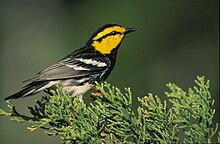Golden-cheeked warbler
| Golden-cheeked warbler | |
|---|---|
 |
|
| Scientific classification | |
| Kingdom: | Animalia |
| Phylum: | Chordata |
| Class: | Aves |
| Order: | Passeriformes |
| Family: | Parulidae |
| Genus: | Setophaga |
| Species: | S. chrysoparia |
| Binomial name | |
|
Setophaga chrysoparia (Sclater & Salvin, 1861) |
|
 |
|
| Range of S. chrysoparia Breeding range Winter range | |
| Synonyms | |
|
Dendroica chrysoparia Sclater & Salvin, 1861 |
|
Dendroica chrysoparia Sclater & Salvin, 1861
The golden-cheeked warbler (Setophaga chrysoparia [formerly Dendroica chrysoparia]), also known as the gold finch of Texas, is an endangered species of bird that breeds in Central Texas, from Palo Pinto County southwestward along the eastern and southern edge of the Edwards Plateau to Kinney County. The golden-cheeked warbler is the only bird species with a breeding range confined to Texas.
The golden-cheeked warbler is very staggering because of its bright yellow cheeks that is counterposed by its black throat and back, but it is found more by its unique buzzing song emerging from the wooded canyons where it breeds. Golden-cheeked warblers form in 33 counties in central Texas and are dependent on Ashe Juniper (blueberry juniper or cedar) for their fine bark stripes for nesting reasons.
The Golden-cheeked Warbler can be found in numerous state parks within Texas. These parks include the “Colorado Bend State Park (SP), Dinosaur Valley SP, Garner SP, Guadalupe River SP, Honey Creek State Natural Area (SNA), Hill Country SNA, Kerr Management Area, Longhorn Cavern SNA, Lost Maples SNA, Meridian SP, Pedernales Falls SP, and Possum Kingdom SP.”
The golden-cheeked warbler (GCWA) are endemic to Texas and no other quarters. Their habitat can range from moist, to dry areas around central and southern Texas. The nesting habitat in the further moist realms can be discovered in tall, closed canopy, compressed, mature stands of Ashe juniper trees along with Texas, shin, live, Lacey, and post oak trees. In the drier spheres of Texas the GCWAs can be found in upland juniper-oak woodlands off of flat topography. They use Ashe juniper bark and spider webs to build their nests. Females lay three to four eggs. When migration and winter hits the habitat stays relatively similar: a variety of short-lived evergreen forests with pines between 3,300 and 8,300 feet.
Golden-cheeked Warblers will only remain in Texas for the breeding season, from March to June. They will migrate with other songbird species along Mexico’s Sierra Madre Oriental. By the first week of March, the Warblers will return to Texas to breed. During the winter season (November–February), Warblers will travel to Guatemala, Nicaragua, Honduras, and Mexico.
...
Wikipedia

